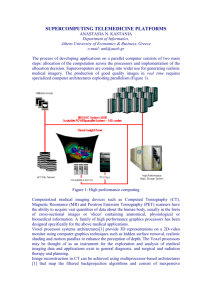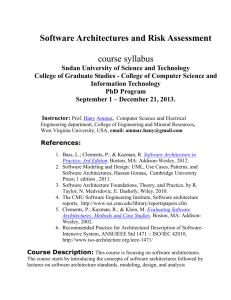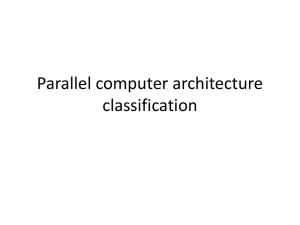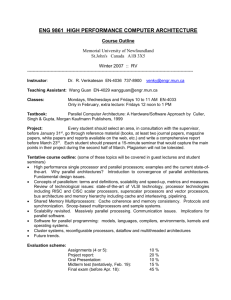2.5 Classification of Parallel Computers
advertisement
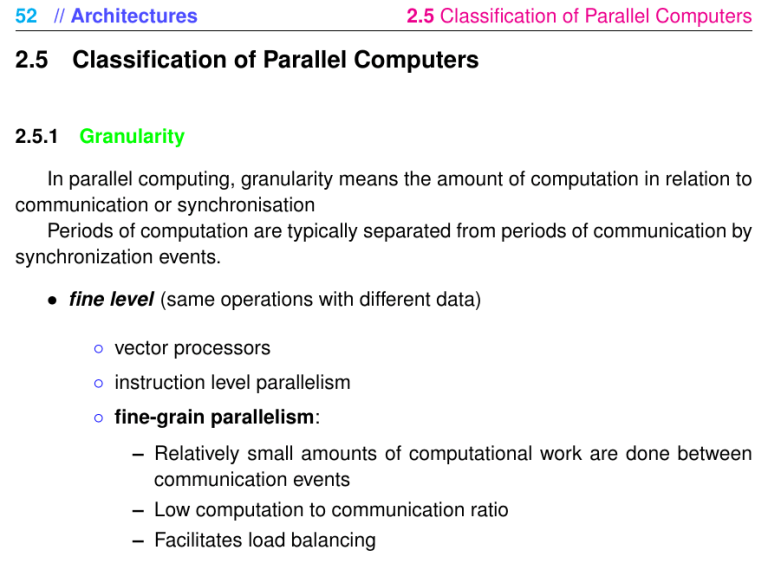
52 // Architectures 2.5 2.5.1 2.5 Classification of Parallel Computers Classification of Parallel Computers Granularity In parallel computing, granularity means the amount of computation in relation to communication or synchronisation Periods of computation are typically separated from periods of communication by synchronization events. • fine level (same operations with different data) ◦ vector processors ◦ instruction level parallelism ◦ fine-grain parallelism: – Relatively small amounts of computational work are done between communication events – Low computation to communication ratio – Facilitates load balancing 53 // Architectures 2.5 Classification of Parallel Computers – Implies high communication overhead and less opportunity for performance enhancement – If granularity is too fine it is possible that the overhead required for communications and synchronization between tasks takes longer than the computation. • operation level (different operations simultaneously) • problem level (independent subtasks) ◦ coarse-grain parallelism: – Relatively large amounts of computational work are done between communication/synchronization events – High computation to communication ratio – Implies more opportunity for performance increase – Harder to load balance efficiently 54 // Architectures 2.5.2 2.5 Classification of Parallel Computers Hardware: Pipelining (was used in supercomputers, e.g. Cray-1) In N elements in pipeline and for ∀ element L clock cycles =⇒ for calculation it would take L + N cycles; without pipeline L ∗ N cycles Example of good code for pipelineing: do i =1 ,k z ( i ) =x ( i ) +y ( i ) end do 55 // Architectures 2.5 Classification of Parallel Computers Vector processors, fast vector operations (operations on arrays). Previous example good also for vector processor (vector addition) , but, e.g. recursion – hard to optimise for vector processors Example: IntelMMX – simple vector processor. Processor arrays Most often 2-dimensional arrays (For example: MasPar MP2 - massively parallel computer ) neighbours and on edges to the corresponding opposite edge nodes. Processors had mutual clock. Programming such a computer quite specific, special language, MPL, was used; need for thinkinking about communication beMasPar-MP2: 128x128=16384 tween neighbours, or to all processor at processors, each had 64Kbytes memory. once (which was slower). each processor connected to its 56 // Architectures 2.5 Classification of Parallel Computers Shared memory computer Distributed systems (e.g.: clusters) Most spread today. One of the main questions on parallel hardware: do the processors share a mutual clock or not? 57 // Architectures 2.5 Classification of Parallel Computers 58 // Architectures 2.6 2.6 Flynn’s classification Flynn’s classification Instruction SISD SIMD (MISD) MIMD Data S - Single M - Multiple I - Instruction Abbreviations: D - Data For example: Single Instruction Multiple Data stream =>: SISD - single instruction single data stream, (e.g. simple PC) SIMD - Same instructions applied to multiple data. (Example: MasPar) MISD - same data used to perform multiple operations... Sometimes have been considered vector processors belonging here but most often said to be empty class MIMD - Separate data and separate instructions. (Example: computer cluster) 59 // Architectures 2.6.1 2.6 Flynn’s classification SISD • A serial (non-parallel) computer • Single Instruction: Only one instruction stream is being acted on by the CPU during any one clock cycle • Single Data: Only one data stream is being used as input during any one clock cycle • Deterministic execution • This is the oldest and even today, the most common type of computer • Examples: older generation mainframes, minicomputers and workstations; most modern day PCs. 60 // Architectures 2.6.2 2.6 Flynn’s classification SIMD • A type of parallel computer • Single Instruction: All processing units execute the same instruction at any given clock cycle • Multiple Data: Each processing unit can operate on a different data element • Best suited for specialized problems characterized by a high degree of regularity, such as graphics/image processing. • Synchronous (lockstep) and deterministic execution • Two varieties: Processor Arrays and Vector Pipelines • Examples:some early computers of this type: ◦ Processor Arrays: Connection Machine CM-2, MasPar MP-1 & MP-2, ILLIAC IV 61 // Architectures 2.6 Flynn’s classification ◦ Vector Pipelines: IBM 9000, Cray X-MP, Y-MP & C90, Fujitsu VP, NEC SX-2, Hitachi S820, ETA10 • graphics cards • Most modern computers, particularly those with graphics processor units (GPUs) employ SIMD instructions and execution units. • possibility to switch off some processors (with mask arrays) 62 // Architectures 2.6.3 2.6 Flynn’s classification (MISD): • A type of parallel computer • Multiple Instruction: Each processing unit operates on the data independently via separate instruction streams. • Single Data: A single data stream is fed into multiple processing units. • Few actual examples of this class of parallel computer have ever existed. One is the experimental Carnegie-Mellon C.mmp computer (1971). • Some conceivable uses might be: ◦ multiple frequency filters operating on a single signal stream ◦ multiple cryptography algorithms attempting to crack a single coded message. 63 // Architectures 2.6.4 2.6 Flynn’s classification MIMD • A type of parallel computer • Multiple Instruction: Every processor may be executing a different instruction stream • Multiple Data: Every processor may be working with a different data stream • Execution can be synchronous or asynchronous, deterministic or nondeterministic • Currently, the most common type of parallel computer - most modern supercomputers fall into this category. • Examples: most current supercomputers, networked parallel computer clusters and "grids", multi-processor SMP computers, multi-core PCs. • Note: many MIMD architectures also include SIMD execution sub-components 64 // Architectures 2.6.5 2.6 Flynn’s classification Comparing SIMD with MIMD • SIMD have less hardware units than MIMD (single instruction unit) • Nevertheless, as SIMD computers are specially designed, they tend to be expensive and timeconsuming to develop • not all applications suitable for SIMD • Platforms supporting SPMD can be built from cheaper components 65 // Architectures 2.6.6 Flynn-Johnson classification (picture by: Behrooz Parhami) 2.6 Flynn’s classification 66 // Architectures 2.7 2.7.1 2.7 Type of memory access Type of memory access Shared Memory • common shared memory • Problem occurs when more than one process want to write to (or read from) the same memory address • Shared memory programming models do deal with these situations 67 // Architectures 2.7.2 Distributed memory • Networked processors with their private memory 2.7.3 hybrid memory models • E.g. distributed shared memory, SGI Origin 2000 2.7 Type of memory access 68 // Architectures 2.8 2.8.1 2.8 Communication model of parallel computers Communication model of parallel computers Communication through shared memory address space • UMA (uniform memory access) • NUMA (non-uniform memory access) ◦ SGI Origin 2000 ◦ Sun Ultra HPC 69 // Architectures 2.8 Communication model of parallel computers Comparing UMA and NUMA: C - Cache, P- Processor, M-Memory / Which (a) & (b) are- UMA, which (c) - NUMA NUMA? 70 // Architectures 2.8.2 2.8 Communication model of parallel computers Communication through messages • Using some messaging libraries like MPI, PVM. • All processors are ◦ independent ◦ own private memory ◦ have unique ID • Communication is performed through exchanging messages 71 // Architectures 2.9 2.9.1 Other classifications Algorithm realisation • using only hardware modules • mixed modules (hardware and software) 2.9.2 Control type 1. synchronous 2. dataflow-driven 3. asynchronous 2.9 Other classifications 72 // Architectures 2.9.3 2.9 Other classifications Network connection speed • network bandwidth ◦ can be increased e.g. through channel bonding • network latency ◦ the time from the source sending a message to the destination receiving it More Whicheasy one to is more increase easy bandwidth! to increase: bandwidth or latency? 73 // Architectures 2.9.4 2.9 Other classifications Network topology • Bus-based networks • Ring - one of the simplest topologies • Array topology ◦ Example: cube (in case of 3D array) • Hypercube ◦ In ring the longest route between 2 processors is: P/2 – in hypercube – log P Ring: 74 // Architectures Hypercube: 2.9 Other classifications 75 // Architectures 2.9 Other classifications Figure. How to design a hypercube: Add similar structure and connect corresponding nodes (adding one 1 bit). Problem: large number of connections per node Easy to emulate Hypercube on e.g. MasPar array in log n time: 76 // Architectures 2.9 Other classifications 77 // Architectures 2.9 Other classifications • Star topology ◦ Speed depends very much on switch properties (e.g. latency, bandwidth, backplane frequency ) and ability to cope with arbitray communication patterns • Clos-network For example Myrinet. (quite popular around 2005) • Cheaper but with higher latency: Gbit Ethernet., (10 Gbit Ethernet) • Nowadays, most popular low-latency network type – Infiniband
